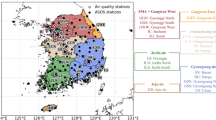Abstract
To aid air quality model development and assess air quality forecasts, the Meteorological Development Laboratory (MDL) provided categorical verification metrics for developmental aerosol predictions. The National Air Quality Forecasting Capability (NAQFC) generated 48 h (of) gridded hourly developmental predictions for the lower 48 states (CONUS) domain in 12 km horizontal spacing. The NAQFC uses the North American Mesoscale (NAM) model with EPA’s Community Multiscale Air Quality (CMAQ) model to produce predictions of ground level aerosol concentrations. We used bilinear interpolation to calculate predicted daily maximum values at the location of the observation sites. We compared these interpolated predicted values to the observed daily maximum to produce 2 × 2 contingency tables, with a threshold of 40 μg/m3 during the months of March–August, 2007. The model showed some degree of skill in predicting aerosol exceedances. These results are preliminary as the NAQFC model for aerosol prediction is in the developmental stage. A more comprehensive performance evaluation will be accomplished in 2008, when more data become available. Our verification metrics included categorical analyses for Fraction Correct (FC) or percent correct (FC × 100), Threat Score (TS) or Critical Success Index (CSI), Probability of Detection (POD), and the False Alarm Rate (FAR), Mean Absolute Error (MAE) and mean algebraic error or bias, where bias is forecast minus observation. Graphic products included weekly statistics for the CONUS displayed in the form of bar charts, scatterplots, and graphs. In addition, we split the CONUS into six geographic regions and provided regional statistics on a monthly basis. MDL produced spatial maps of daily 1-h maximum predicted aerosol values overlaid with the corresponding point observations. MDL also provided spatial maps of the daily maximum of the 24-h running average. We derived the 24-h running average from the 1-h average predicted aerosol values and observations.
Similar content being viewed by others
References
Binkowski FS, Roselle SJ (2003) Models-3 Community Multiscale Air Quality (CMAQ) model aerosol component: 1: model description. J Geophys Res 108(D6): 4183. doi:10.1029/2001JD001409
Eder B, Kang D, Mathur R, Yu S, Schere K (2006) An operational evaluation of the Eta-CMAQ air quality forecast model. Atmos Environ 40(26): 4894–4905. doi:10.1016/j.atmosenv.2005.12.062
Gery MW, Whitten GZ, Killus JP, Dodge MC (1989) A photochemical kinetics mechanism for urban and regional scale computer modeling. J Geophys Res 94: 925–956. doi:10.1029/JD094iD10p12925
Janjic ZI (2003) A nonhydrostatic model based on a new approach. Meteorol Atmos Phys 82: 271–285. doi:10.1007/s00703-001-0587-6
Jiang W, Smyth S, Giroux E, Roth H, Yin D (2006) Differences between CMAQ fine mode particle and PM_2.5 concentrations and their impact on model performance evaluation in the lower Fraser valley. Atmos Environ 40: 4973–4985. doi:10.1016/j.atmosenv.2005.10.069
Lee P, Mathur R, McQueen J, Kondragunta S, Pleim J, Young J etal (2005) Eta CMAQ modeling system’s capability to provide PM2.5 and aerosol optical thickness forecast. Preprints, 7th conference on atmospheric chemistry, January, 10–13, 2005, San Diego, California. American Meteorological Society, Boston, CD-ROM 4.6
Mebust MR, Eder BK, Binkowski FS, Roselle SJ (2003) Models-3 Community Multiscale Air Quality (CMAQ) model aerosol component: 2: model evaluation. J Geophys Res 108(D6): 4184. doi:10.1029/2001JD001410
Schell B, Ackermann IJ, Hass H, Binkowski FS, Ebel A (2001) Modeling the formation of secondary organic aerosol within a comprehensive air quality model system. J Geophys Res 106: 28275–28293. doi:10.1029/2001JD000384
Wilks DS (1995) Statistical methods in the atmosphic sciences: an introduction. Academic Press, New York, pp 238–241
Author information
Authors and Affiliations
Corresponding author
Rights and permissions
About this article
Cite this article
Gorline, J.L., Lee, P. Performance evaluation of NOAA-EPA developmental aerosol forecasts. Environ Fluid Mech 9, 109–120 (2009). https://doi.org/10.1007/s10652-008-9090-7
Received:
Accepted:
Published:
Issue Date:
DOI: https://doi.org/10.1007/s10652-008-9090-7




